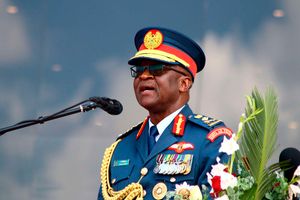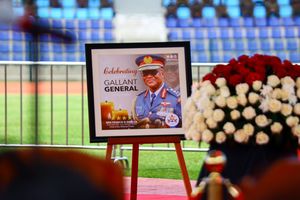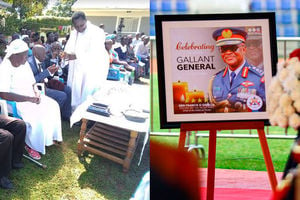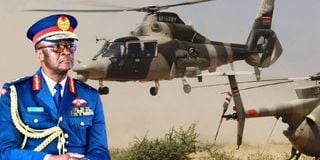
Gen Francis Ogolla who died in a chopper crash on April 18, 2024. Right: Kenya Defence Forces’ combat helicopters during Operation Linda Nchi.
The Ministry of Defence has singled out engine failure for the crash of a Bell Huey aircraft that killed Chief of Defence Forces (CDF) Francis Ogolla and nine others in April last year. The ministry revealed that there was an engine overhaul despite two previous inspections indicating there was no problem.
One sentence in the 1,600-word summary report released yesterday reads: “An overhauled engine was installed on December 12, 2023.”
There are no explanations on what necessitated the overhaul of the chopper’s engine. Instead, the summary packs an elaboration of how the engine underwent regular inspections following the installation.
“The last scheduled servicing was 25 hours which was conducted from April 2 to 5, 2024 and the helicopter was(at the time of the crash) left with 19 flight hours to the next 100 hours scheduled servicing,” said the report by the board of inquiry.
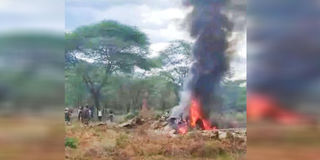
A scene where a KDF helicopter carrying Chief of Defence Forces General Francis Ogolla and 11 others crashed at Sindar, Kaben Location at the border of Elgeyo Marakwet and West Pokot counties.
The chopper crashed 128 days after an overhauled engine was installed in the American-made aircraft.
It leaves more questions when one considers another line in the report that “no major defects” were found when major inspections happened between June 2021 and October 2023 yet the engine was overhauled in December of the same year with the report not indicating the reasons for this.
The anomaly may get explanations in the coming days, but a plain reading of the report – which was handed to President William Ruto on Friday – suggests the possibility of unexplained factors on the accident.
The investigators then centred on the engine for various reasons. One of them was the reading of a device in the cockpit called the measured gas temperatures (MGT) gauge.
“When powered,(it) displayed an over-exceedance of 914°C,” the report said.
That temperature is too high even for metal. Aluminium, one of the metals used in making aircraft bodies, melts at 660°C.
The investigators wrote that the engine suffered an engine compressor stall. Online sources say this phenomenon happens when there is an abnormal airflow to the compressor of the engine. According to skybrary.aero, an engine compressor stall makes a helicopter’s rotors behave unconventionally, and it can lead to a loss of thrust and a weird “backfire” sound.
“It may also be accompanied by flame from either or both of the engine inlet and engine exhaust,” the aviation site says.
In the report, the investigators said the “witness report of a loud bang at the engine compartment” was proof of the engine compressor stall.
“The helicopter then experienced a complete power loss which was followed by a left yaw (sudden turn), drop in engine RPM (revolutions per minute), low RPM audio alarm and change in engine noise, as narrated by witnesses on the ground and accident scene reconstruction,” it noted.
The report further noted: “Dependent on information from the survivors, after experiencing complete power loss, the pilots of (the chopper) attempted to control the helicopter to a clear landing zone but lost positive control of the aircraft.”
“Based on facts and evidence gathered, and indicated in the findings above, the board of inquiry is of the opinion that the (chopper) crashed due to engine malfunction.”
The Bell UH-1H-II (Huey) Helicopter KAF 1501, one of eight choppers that had been acquired from the US in 2016, had been involved in numerous flights locally.
The report says the eight aircraft “have been extensively used on duties pertaining to operational missions and peacetime roles and variedly tasked to ferry personnel, logistical supplies and fire extinguishing among other assignments in the Kenya Defence Forces”.
On that fateful day of April 18, 2024, General Ogolla was visiting the North Rift to touch base with troops carrying out Operation Maliza Uhalifu. His aircraft left Nairobi that morning, destined for Chesitet. After Chesitet, they flew to Kainuk and later to Cheptulel Boys. Upon leaving Cheptulel Boys, at around 2.20pm, the crash happened. The chopper landed on a farm and caught fire on impact.
The nature of damage has been classified as category five, meaning destruction beyond economic repair. The report offered a rare glimpse of how the site looked after the evacuation, showing a disintegration of the chopper’s components.
On impact, 8 of the 12 inside died. Four survived, though two died shortly afterwards. Only two in the crew of 12 are alive, and their testimonies formed a core part of the investigation.
The 10 who died were General Ogolla, Brigadier Swale Saidi (commander of the combat engineers brigade); Colonel Duncan Keittany (who was on the operations side at the Defence headquarters); Lieutenant Colonel David Sawe (a staffer at the Defence headquarters); Major George Benson Magondu (the pilot); and Captain Sora Mohamed (the co-pilot).
There was also Captain Hillary Litali (General Ogolla’s aide-de-Camp); Senior Sergeant John Kinyua Mureithi (a flight technician); Sergeant Cliphonce Omondi (part of General Ogolla’s Security); and Sergeant Rose Nyawira (part of General Ogolla’s media team).
The survivors were Cpl Frankford Karanja Mogire (who was part of General Ogolla’s media team) Colonel Kasaine Ole Kuruta (a staffer at the Defence headquarters).
The analysis of the crash looked at the crew and the external conditions.
Were the pilots well trained? To answer this question, the board looked at their education. The pilot, they say, started his training at the Kenya Air Force Training School “before proceeding to Starlite International Aviation Academy in the Republic of South Africa from April 2, 2016 to April 2, 2017”.
At the time of the crash, the report said, he had accumulated a total of 1,731.40 flight hours.
The co-pilot, the team found, had first trained at the Starlite International Aviation Academy from February 2019 to January 2020. At the time of the crash, he had accumulated a total of 955.45 flight hours.
“Both pilots were mission-ready in accordance with Flying Order Book (FOB), Squadron Standard Operating Procedures (SOPs), categorization, instrument rating and annual aircrew medicals. The board of inquiry concluded that the crew had sufficient flying hours to be considered above average captain and co-pilot respectively. Aircrew aspect was therefore a less likely contributing factor,” the team wrote.
While reviewing the demeanour of the crew, the board noted that the pilot was “very experienced and competent”, while his assistant was “a slightly reserved individual who communicated well when required”.
“This was a good crew combination. Crew coordination was less likely to be a contributing factor,” the report said.
With that out of the way, was the chopper technically sound? To probe that, the team looked at the fuel, the gearbox oil, and the hydraulic fluid. The recovered fluids were subjected to tests and “results found to be within normal ranges”.
The team also looked at hardware like the gearbox, the mast assembly among other components.
“(The gears) were examined by Bell Helicopter Textron, USA and the components revealed no evidence of seizure or fractured gear teeth,” said the report.
The team also found out that the technician on board had sufficient maintenance training and so was “considered to be adequately trained to manage the flight”.
The board also did not find faults in the planning of the flight or the weight the aircraft was carrying. The weather, too, was found to be conducive for flight.
Was there a communication failure? The investigators found no evidence of this, as “the crew were in constant two-way communication with other relevant stations”.
The section that touches on an engine overhaul reads: “The helicopter underwent other scheduled servicing such as 25 hours inspection on December 14, 2023. An overhauled engine was installed on December 12, 2023. Additionally, the helicopter underwent 50 hours inspection on January 9, 2024, 75 hours inspection on January 29, 2024 and 100 hours inspection on February 11, 2024, 25 hours inspection on February 22, 2024 one hundred and 150 hours inspection on March 17, 2024 respectively.”
The report noted that on the recommendations of the enquiry board, “the Kenya Air Force has updated and reviewed its standard operating procedures to avert future occurrence”.
With that, a question lingers: What is this preventable aspect of the engine failure that caused a review of the standard operating procedures?
eondieki@ke.nationmedia.com

